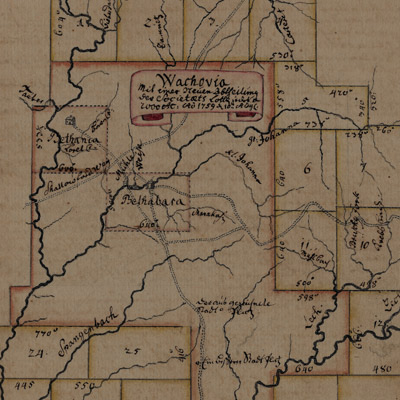North Carolina: A New Home
Moravian Origins | North Carolina: A New Home | A Center of Commerce and Trade | The First Sisters | Bethabara’s Enslaved | Moravians at War
 “Among fifty members brought up in our congregation, or who have lived with us some years, there is probably not one who could maintain himself alone in the forest. They have had no experience, and even those who have the intelligence do not know how.”
“Among fifty members brought up in our congregation, or who have lived with us some years, there is probably not one who could maintain himself alone in the forest. They have had no experience, and even those who have the intelligence do not know how.”
-Bishop Spangenberg’s survey diary, 1752.
Despite concerns that the congregation was ill-equipped to handle the harsh life of the frontier, the Moravians decided to accept an offer from Lord Granville to purchase land in North Carolina. There, they could resettle refugees who were escaping persecution in Europe while also generating money for the Moravian Church
The Moravian expedition bound for North Carolina left Bethlehem, Pennsylvania in the early morning of October 8, 1753. Fifteen Brethren set out on the long journey to Wachovia. Four of them were to learn the route down the Great Wagon Road and return to lead the way for future settlers. The eleven others had unique skills that made them ideal candidates to lay the groundwork of the new settlement.
The Chosen Eleven Settlers
Bernard Grube (37) – minister
Jacob Loesch (31) – town manager
Hans Kalberlan (31) – physician and surgeon
Friedrich Pfeil (28) – shoemaker and nurse
Erich Ingelbretsen (31) – millwright and carpenter
Henrich Feldhausen (38) – shoemaker, carpenter, millwright, cooper, turner, and farmer
Jacob Lung (40) – gardener and washer
Hans Petersen (28) – tailor and woodcutter
Johannes Beroth (28) – farmer
Christopher Merkly (39) – baker and farmer
Hermannus Loesch – (27) – miller and surveyor
Over the next 40 days, they walked approximately 520 miles with six horses and a wagon full of supplies. Although some of their journey was pleasant, there were treacherous moments when they came across “bad roads,” sections of the trail that became impassable following heavy rains. Because few bridges were constructed at the time, they crossed flooded rivers and streams at their shallowest point, provisions held above their heads as they crossed the rushing water.
Despite the difficult journey, the party arrived at the northern border of Wachovia at 12:30 P.M. on November 17, 1753, a frigid day, threatening snow. They followed a road to the boundary of their tract, then cut new road the remaining two and a half miles to a cabin built and abandoned the previous year by a hunter named Hans Wagner.
Little sleep was had that first, freezing night. The next day was spent resting and hunting game. On November 19th, the true work began as the Brethren started clearing land, planting corn, and building a bake oven; laying the foundation for what would become the Bethabara settlement.
